Wanting to get an early start, we were up before 7:00am - right along with the sun as it crested the ridges to the east. Climbing out of the tent, we were pleasantly surprised to find the rain fly completely dry, having expected that it'd be dripping wet after a night in the rainforest.

Nestled off the road, we'd slept well, undisturbed all night.
As with a couple of our recent trips, we decided to skip official breakfasts on this adventure, opting instead for snacking on trail mix and blueberries - something that allows us to get out of camp quickly and eliminates the need for milk in the fridge. Knowing we had a full day ahead of us, we soon set off through the tunnels of trees towards the first - of several - rainforest hikes.

Even though it was dry, the cool blue light of morning lent the perfect atmosphere as we descended the ridge.

Below us, fog blanketed the landscape.
Half an hour after leaving camp, we'd found the trailhead to the Quinault Rain Forest hike, had a few handfuls of trail mix, and availed ourselves of the restrooms. We had two choices at this point - to do a shorter - 1 mile - hike, or a longer 5-mile trek that would wind us through varied terrain. And, though I'd planned for us to do the shorter jaunt, the offer of a deeper dive - as usual - won out. We'd just have to figure out how to adjust our schedule later!

The Olympic Peninsula is home to many of the largest trees in the world. This fir towered several hundred feet into the air.
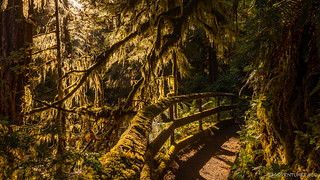
Mossy glow.

Generations.
Our hike through the rainforest found us winding through groves of towering trees - primarily cedar, spruce, and fir. Strolling through fields of ferns - many varieties blanketing the forest floor. Ducking under limbs draped in moss - glowing golden in the early morning sun. We were even treated to displays of cascading waterfalls and colorful fungi, staples of this perpetually damp environment.
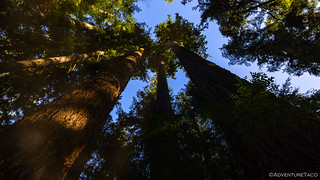
Don't forget to look up.
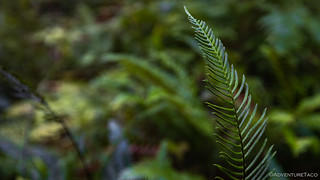
Delicate deer fern fronds.

I've never seen - or noticed - a fungi so white on the bottom and brown on the top.
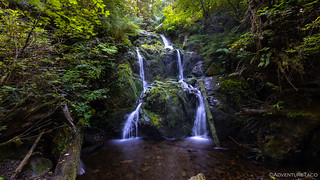
Cascade Creek had a beautiful falls.

Cathedral of green.
A few miles into our five-mile loop, the rain forest trail spit us out along the southern shore of Lake Quinault at the stunning lodge. Surely, if one desired a luxurious stay - no matter if the weather was perfect like today or overcast and gloomy as it must be much of the year - this would fit the bill. And, for those of us who enjoy camp sites with limited connectivity - the lodge only allows 30 minutes of WiFi per guest, per day!

Designed in 1926 by Robert Reamer, the lodge is reminiscent of Reamer's work at the Old Faithful Inn in Yellowstone National Park.

A perfect place to take a load off for a moment.

Standing guard.
From the lodge, we worked our way along the lakeshore for a couple of miles, eventually completing our loop and climbing into the truck for a short drive to one final nearby attraction - the World's Largest Spruce.
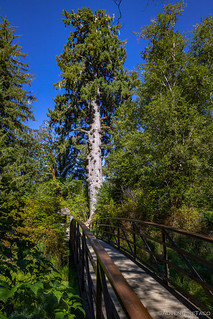
The biggest spruce in the world. Sort of.
It turns out that this spruce - which apparently is tied for the title of "largest" - acquired that title not by how tall it is, nor by its mass. Rather, the number of "points" determines the largest tree. Now, I don't have any idea what that really means, and it sounds like a pile of baloney, but apparently this tree has 922 of the little buggers, and the co-champion tree in Oregon had - past tense, as it fell to a storm in 2007 - 902 points. Curiously, there is a larger - by mass - spruce only 45 minutes from this one, but as it is not an attraction at the local RV park, it apparently isn't qualified for the world record. 
Having planned an hour - but spent three - at Lake Quinault, it was time for us to transition to the next phase of the traverse around the Olympic Peninsula. The western portion - both through rainforests and along shorelines - kicked off similarly to the southern section. That's right, tree tunnels!

More filtered light.
There seemed to be even fewer breaks in the trees along this segment - perhaps an indication of the additional rainfall that the western slopes of the ranges here receive. Here along the western edge, rainfall totals surpass 135" per year, compared to the rain shadow cast on the eastern flanks that receives only 20-30" annually. Still, when there were small openings in the canopy, our heads were on swivels, and we soaked in the views.

There are fabulous mountains to the east!
Perhaps to be expected, the plethora of pine (and fir and cedar) meant that much of this land was used for logging. In fact, we commented how strange it was that all this land - as the route wound its way north - was privately owned. Our speculation as to the ownership was confirmed as we passed several active operations, each cutting and sorting their bounty.

This crane hauls cut trees up the steep slopes to the platform where they are loaded onto trucks.

A skidder and loader sorted logs right on the road we were travelling. Guess they don't see much traffic!
After winding our way around in the forest for another hour or so, we popped out near Queets - at the southern end of a series of beaches - where we followed the highway north for a short spell. By now, our stomachs - held over only by a bit of trail mix and some blueberries - were also in full starvation mode, and we decided that lunch at Beach 1, or maybe Beach 2 (seriously, those are the names - up to Beach 7 or 10 or some such) would be a great place to enjoy the surf.

The Olympic National Park - more than any other we've visited - seems to be disjointed, encompassing different areas on the peninsula. The numbered beaches are in the Park.
Prioritizing food over fun, we ate a quick lunch while fighting off the local raven riff-raff, before following a short trail to the beach. This took all the willpower we could muster, as the otherwise sunny day was anything but here at the seashore. The fog - burned off everywhere else - was still fighting the good fight as it pushed in off of the ocean, making for a magically misty experience as we finally reached the sand.

This is what I think of when someone says, "Olympic Peninsula."

Through the mist.

To the ocean.

It was as though we could transition - with a single step - between two entirely different climates by retreating from the beach.
Lunch behind us - and our bellies no longer threatening mutiny - we dove back onto dirt and through the trees along a circuitous route to the Hoh Rain Forest. Unsurprisingly, the landscape was familiar.
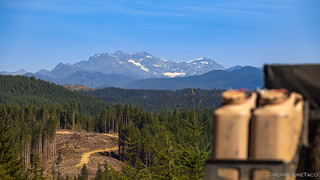
A perfect summary. Forests, logging, mountains, glaciers, and roads - this is the Olympic Peninsula.
After waiting for a bit of road work along Hoh Road - not the most fortunate of names, we decided - we reached the parking area right around 4:30pm. Unbeknownst to us, this turned out to be perfect timing as it meant that the days crowds were on their way out, and while we wouldn't have the trails to ourselves, they wouldn't be all that crowded, either.
We'd do two loops over the next hour - through the Hall of Mosses and along the Spruce Nature Trail - each one winding through different elements of the same rain forest.

Late afternoon sun filtered down through the vine maple, reaching for the forest floor.
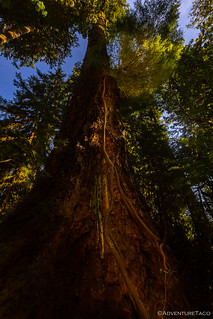
Here, trees can - and do - grow anywhere. Including 40-feet up another towering giant, roots - like filtered sun - straining to reach the ground.

Rambunctious root ball. A fallen tree one occupied the space under these roots, providing life to the next generation.
Of the two hikes, the Hall of Mosses was certainly the highlight - not so much for the mosses in particular - but simply because the landscape was more varied. This may also have been partially due to the weather; the sunny day afforded significantly more light on the mosses loop, something we both enjoyed.

An auspicious entrance to the Hall of Mosses.

There's no secret behind the naming.
Transitioning to the Spruce Nature Trail, I think we were both excited by the fact that the trail worked its way out to the Hoh River. This - it would turn out - would be a case of expectations surpassing reality, as the Hoh River at this point wasn't all that beautiful, but we enjoyed the 1.2-mile loop nonetheless, as we had it entirely to ourselves.

Forest of ferns under a palace of pine.

When one falls, many rise.

The Hall of Mosses wasn't the only place giving off a warm yellow glow this evening.
One of the nice things about our double-loop hike was that the terminus of the second loop popped us out at the parking lot, just a few feet from our trusty Tacoma. Now nearing 6:00pm, we had a decision to make - look for camp somewhere nearby, or try to cover more ground on a route that seemed to grow with every mile we traveled.
Perhaps a bit out of character, we opted to look for a camp site. Mostly, this was because we'd spotted a road that we hoped might lead down to a gravel bar on the Hoh River. Spending the night there - with the quiet rippling of the late-summer flow - would be quite a treat, as long as no one else had come up with the idea before we had!

Time for dinner.
It turns out that the first - and most promising - road we followed was in fact occupied. The gravel bar was big enough to allow for two camp sites, but with the other residents away from camp when we arrived, we decided that setting up without asking was probably not the best way to make friends.
Instead, we wandered down a second road, and were obviously delighted to find that there were several camp sites right along the river. In fact, the two other campers had - conveniently for us - the second and third best spots, leaving us with the primo site at the very end of the gravel bar.
Dinner - a tasty meal of Vietnamese chicken, Asian slaw, green beans, and rice - was reheated in aluminum foil over the stove, and soon we were enjoying it in our rocking camp chairs as the water floated by and the sun set on the horizon.
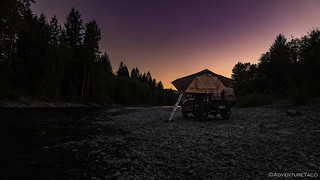
A glorious end to a glorious day.
Nodding off to sleep, and halfway - at least by distance - through our trip, we had no idea this would be our last night in the tent. As they say, "best laid plans..."




Dang, some of the best pictures yet! Especially the mossy side of things!!
Thanks Bill! I was very pleasantly surprised with our time in the rainforest; I'd expected it to be just a dark and dreary place (as I admit to feeling at home through the fall/winter/spring months when we have less than 8 hours of light each day and a seemingly endless drizzle), hahaha! Was so nice to have a great time on that hike!
Wonderful photos! I think it's been around 20 years since we were up in that area going through the coastal forests and doing a fair amount of hiking. It's a beautiful area from Washington down through Oregon to the Northern California forests. Very different than that the drier forests down here in Southern California. Thanks for sharing your journey, appreciate it since we'll certainly never be able to go up that way again.
Thanks John! Always glad to bring back those fond memories. As for the wetter forests - more and more, they seem to be mid-Oregon and north now, as the climate is changing. We spend a good amount of time in the Shasta area in NorCal, and that's just as dry as any forest I spent time in when I was a kit (in the Quincy area). Hopefully more rain and snow happen in the next several years - the entire Sierra needs it!